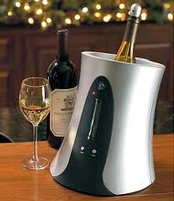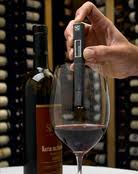One of the most enduring myths of wine appreciation is the quaint notion of room temperature. If you have even a passing interest in wine, you have no doubt heard it said that red wine should be served at "room temperature."
 I have a problem with that, and as the days grow warmer with the onset of summer, so should you. It is my considered opinion that the enophile who first set forth the "room temperature" commandment must have lived in a dungeon.
I have a problem with that, and as the days grow warmer with the onset of summer, so should you. It is my considered opinion that the enophile who first set forth the "room temperature" commandment must have lived in a dungeon.
Why is this important? Unless you keep your thermostat at a chilly 64 degrees Fahrenheit year-round, room temperature red wines could leave a bad taste in your mouth more often than not. This is especially true if you are prone to cut the air conditioning and throw open the windows on a warm summer day.
Take a popular red such as Cabernet Sauvignon. If served at a temp in the mid-to-high 70s, it can taste astringent and lacking in fruit or otherwise be dull, flabby and boring. The optimum temperature for Cabernet is between 64 F and 66 F. Pinot Noir and lighter reds, such as Chianti and Beaujolais, are more enjoyable at even cooler temps.
Serving a red wine too warm diminishes your pleasure and isn’t fair to you or the wine, especially an expensive wine. The worst offenders are restaurants. Anyone who has dined out in summer has likely been presented a bottle that seemed warm to the touch. This is especially true in Europe, where so many restaurants operate without air conditioning, but it happens throughout the U.S., as well.
The easiest and quickest solution is to ask for an ice bucket. Don’t be intimidated by the frown of the waiter. Ten minutes in a bucket of ice will do wonders for that warm Merlot. If by chance you give it too much of a chill, no worries: The wine will quickly warm back up to the proper temperature on a summer day.
 One easy way to test the theory about serving temperature is to organize a blind tasting of several red wines. Put the same wine in the blind tasting twice, but make sure one of them is served cool and the other served warmer than the optimum. Tasters would be hard pressed to identify the identical wines as the same wine when tasted at different temps. And they would almost certainly prefer the cooler wine rather than the warmer wine.
One easy way to test the theory about serving temperature is to organize a blind tasting of several red wines. Put the same wine in the blind tasting twice, but make sure one of them is served cool and the other served warmer than the optimum. Tasters would be hard pressed to identify the identical wines as the same wine when tasted at different temps. And they would almost certainly prefer the cooler wine rather than the warmer wine.
Temperature can be just as important for white wines, as well. Crisp, high acid whites are best served very cold. That preserves the essence of their appeal. A Gruner Veltliner, Albarino or Pinot Grigio served too warm will seem flabby and lacking in character.
On the other hand, more full-bodied whites, such as Chardonnay or Riesling, will seem closed and less flavorful if served too cold. The complexities of these wines only begin to emerge as the wine warms in the glass. To my palate, 48-50 F is an ideal temp for Chardonnay and Riesling. Crisper, lighter whites should be served even colder.
Of course, it all comes down to taste, and you should play with the possibilities and find the correct temp for what you like.
Room temperature, after all, should be wherever you decide to set the thermostat.
8
